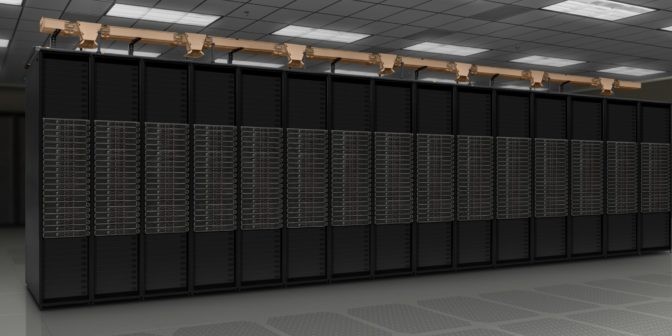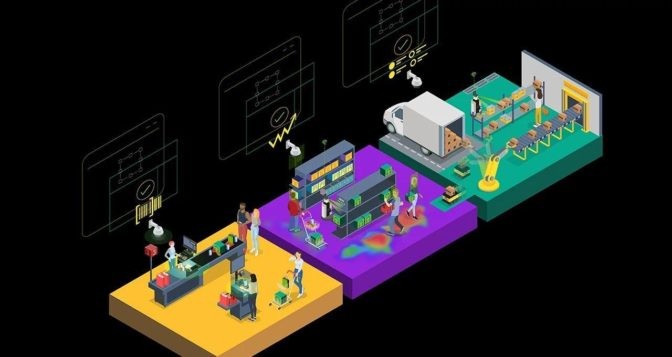Edge computing brings computation closer to the data source, while cloud computing relies on centralized data centers; COMPARE.EDU.VN helps you understand the nuances. This detailed comparison sheds light on when to use each approach, and how they can complement each other, providing optimal solutions for various applications. Discover the benefits of decentralized processing, data sovereignty, and low latency versus the scalability, cost-efficiency, and simplified IT management of cloud solutions, empowering you to make informed decisions.
1. Understanding Cloud Computing
Cloud computing is a transformative model where scalable and elastic IT capabilities are delivered as a service over the internet, according to Gartner. This paradigm shift enables organizations to access computing resources on demand, paying only for what they use.
1.1. Key Advantages of Cloud Computing
Cloud computing offers a multitude of benefits, making it a cornerstone of modern IT infrastructure. A Harvard Business Review report indicates that 83% of respondents consider the cloud very or extremely important for their organization’s future strategy and growth.
- Lower Upfront Costs: Cloud computing eliminates the need for significant capital expenditure on hardware, software, IT management, and infrastructure maintenance.
- Flexible Pricing: Organizations pay only for the computing resources they consume, offering greater cost control and predictability.
- On-Demand Scalability: Cloud services dynamically adjust to changing demands by automatically provisioning and deprovisioning resources.
- Simplified IT Management: Cloud providers offer access to IT management experts, freeing up internal staff to focus on core business objectives.
- Easy Updates: Access to the latest hardware, software, and services is streamlined with one-click updates.
- Reliability: Data backup, disaster recovery, and business continuity are enhanced through data mirroring across multiple redundant sites.
- Time Savings: The elimination of private server and network configuration reduces deployment time, accelerating time-to-market.
2. Exploring Edge Computing
Edge computing involves processing data closer to the source of generation, typically at the edge of a network, near Internet of Things (IoT) devices or sensors. This approach enhances data processing speed, increases bandwidth efficiency, and ensures data sovereignty.
2.1. The Core Principles of Edge Computing
Edge computing reduces the need to transmit large volumes of data to centralized servers, cloud platforms, or remote locations for processing. This is particularly vital for modern applications that rely on real-time data analysis and AI.
3. Unveiling the Benefits of Edge Computing
Gartner predicts that enterprises with edge use cases in production will surge from 5% in 2019 to approximately 40% in 2024. This growth reflects the increasing recognition of edge computing as a critical enabler for high-compute applications, including deep learning, data processing, simulation, and video streaming.
3.1. Key Advantages of Edge Computing
- Lower Latency: Processing data at the edge minimizes data travel, accelerating insights for applications with stringent latency requirements, such as autonomous vehicles and augmented reality.
- Reduced Costs: Utilizing local area networks for data processing provides higher bandwidth and storage at lower costs compared to cloud computing.
- Improved Model Accuracy: Edge computing allows for higher accuracy AI models, crucial for real-time responses. Data feedback loops enhance model precision, and multiple models can run simultaneously.
- Wider Reach: Edge computing can process data locally, even without internet access, extending computing capabilities to remote or inaccessible locations.
- Data Sovereignty: Edge computing allows organizations to maintain sensitive data within the local area network and company firewall, reducing exposure to cyberattacks and ensuring compliance with data protection regulations.
4. Cloud Computing’s Role in Edge AI
Both edge and cloud computing can effectively utilize containerized applications, which are easy-to-deploy software packages capable of running on any operating system. These containers abstract the application from the host OS, ensuring cross-platform compatibility.
4.1. Containerization in Edge and Cloud
The primary distinction between cloud and edge containers lies in their location. Edge containers are deployed at the network edge, closer to the data source, while cloud containers operate within a data center.
Organizations with existing containerized cloud solutions can seamlessly extend these deployments to the edge, leveraging the benefits of both environments.
4.2. Cloud-Native Technologies for Edge AI
Organizations often adopt cloud-native technologies to manage their edge AI data centers. These data centers may contain servers in numerous locations, often lacking physical security or trained staff. Consequently, edge AI servers must be highly secure, resilient, and easily manageable at scale.
5. Choosing Between Edge and Cloud Computing
Edge and cloud computing each offer distinct advantages, and most organizations benefit from integrating both approaches. Key considerations when deciding where to deploy specific workloads include:
5.1. Cloud Computing Use Cases
- Non-time-sensitive data processing
- Environments with reliable internet connectivity
- Dynamic workloads requiring scalability
- Data storage in the cloud
5.2. Edge Computing Use Cases
- Real-time data processing
- Remote locations with limited or no internet connectivity
- Large datasets that are too costly to transfer to the cloud
- Highly sensitive data requiring strict data governance
5.3. Illustrative Scenario
Consider medical robotics, where surgeons require real-time data access. While much of the system software could run in the cloud, the smart analytics and robotic controls essential in operating rooms cannot tolerate latency, network reliability issues, or bandwidth constraints. In this scenario, edge computing offers crucial life-saving benefits.
6. Hybrid Cloud Architecture: The Best of Both Worlds
For many organizations, a convergence of cloud and edge computing is essential. They centralize when possible and distribute when necessary. A hybrid cloud architecture enables enterprises to leverage the security and manageability of on-premises systems while also utilizing public cloud resources from a service provider.
6.1. Varied Hybrid Cloud Solutions
A hybrid cloud solution can take many forms, including training models in the cloud and deploying them at the edge, training in the data center and using cloud management tools at the edge, or training at the edge and using the cloud to centralize models for federated learning. The opportunities for integrating cloud and edge are virtually limitless.
7. Detailed Comparison: Edge Computing vs. Cloud Computing
To provide a clearer understanding, here’s a detailed comparison of edge computing and cloud computing across various key parameters.
| Feature | Edge Computing | Cloud Computing |
|---|---|---|
| Latency | Very Low (Real-time) | High (Dependent on network) |
| Connectivity | Can operate with limited or no internet | Requires stable internet connection |
| Data Location | Close to data source | Centralized data centers |
| Scalability | Limited by physical hardware at the edge | Highly scalable and elastic |
| Cost | Potentially lower for bandwidth-intensive apps | Cost-effective for variable workloads |
| Security | Enhanced data sovereignty and reduced attack surface | Requires robust cloud security measures |
| Use Cases | Autonomous vehicles, real-time analytics, IoT | Data storage, application hosting, disaster recovery |
| IT Management | Requires local management at the edge | Simplified, provider-managed |
| Processing Power | Distributed, localized processing | Centralized, high-performance computing |
| Data Volume | Optimized for processing large local datasets | Suitable for managing and processing vast datasets |


8. Specific Use Cases: When to Choose Edge or Cloud
To further illustrate the differences, let’s examine specific use cases where one technology might be more suitable than the other.
8.1. Edge Computing Use Cases
- Autonomous Vehicles: Real-time processing of sensor data for navigation and safety.
- Smart Manufacturing: Analyzing data from IoT sensors on the factory floor to optimize production processes.
- Healthcare: Remote patient monitoring with real-time alerts.
- Retail: In-store analytics for personalized customer experiences.
- Remote Monitoring: Deploying AI models where no physical security or trained staff.
8.2. Cloud Computing Use Cases
- Data Storage and Backup: Securely storing and backing up large volumes of data.
- Software as a Service (SaaS): Delivering applications over the internet, accessible from any device.
- Disaster Recovery: Ensuring business continuity by replicating data and applications in the cloud.
- Big Data Analytics: Processing and analyzing massive datasets for business intelligence.
- Application Development and Testing: Providing a scalable and cost-effective environment for developing and testing applications.
9. The Hybrid Approach: Combining Edge and Cloud Strengths
A hybrid approach leverages the strengths of both edge and cloud computing to create a comprehensive and optimized IT infrastructure.
9.1. Examples of Hybrid Solutions
- Training AI Models in the Cloud, Deploying at the Edge: Using the cloud’s vast compute resources to train complex AI models and then deploying them on edge devices for real-time inference.
- Data Pre-processing at the Edge, Analysis in the Cloud: Processing raw data at the edge to reduce its volume and then sending the refined data to the cloud for further analysis and long-term storage.
- Centralized Management with Distributed Processing: Managing edge devices and applications from a central cloud platform while processing data locally at the edge.
10. Future Trends in Edge and Cloud Computing
The convergence of edge and cloud computing is expected to accelerate in the coming years, driven by the increasing demand for real-time data processing, AI-powered applications, and IoT deployments.
10.1. Emerging Trends
- Serverless Edge Computing: Executing code at the edge without managing servers, simplifying deployment and management.
- AI at the Edge: Deploying AI models on edge devices to enable real-time decision-making and automation.
- 5G and Edge Computing: Leveraging the low latency and high bandwidth of 5G networks to enhance edge computing capabilities.
- Edge-to-Cloud Security: Implementing robust security measures that span both the edge and the cloud to protect data and applications.
11. Making the Right Choice for Your Organization
Choosing between edge and cloud computing, or adopting a hybrid approach, depends on the specific needs and requirements of your organization.
11.1. Key Considerations
- Latency Requirements: How critical is real-time data processing for your applications?
- Connectivity Constraints: Do you need to operate in remote locations with limited or no internet access?
- Data Sovereignty: Are there strict data governance regulations that you must comply with?
- Cost Optimization: What is the most cost-effective way to process and store your data?
- Scalability Needs: How much do you need to scale your computing resources?
By carefully evaluating these factors, you can determine the optimal deployment strategy for your workloads and achieve your business objectives.
12. FAQs: Edge Computing vs. Cloud Computing
Here are some frequently asked questions to further clarify the differences and applications of edge and cloud computing.
12.1. What is the primary difference between edge and cloud computing?
Edge computing processes data closer to the source, reducing latency, while cloud computing relies on centralized data centers.
12.2. When should I use edge computing?
Use edge computing for applications requiring real-time processing, low latency, and operation in remote locations with limited connectivity.
12.3. When should I use cloud computing?
Use cloud computing for data storage, application hosting, disaster recovery, and big data analytics, especially when scalability and cost-effectiveness are critical.
12.4. What is a hybrid cloud architecture?
A hybrid cloud architecture combines on-premises systems with public cloud resources, allowing organizations to leverage the strengths of both environments.
12.5. How does edge computing improve AI model accuracy?
Edge computing allows for data feedback loops to enhance AI model accuracy, and multiple models can run simultaneously.
12.6. What are the security benefits of edge computing?
Edge computing enhances data sovereignty and reduces the attack surface by keeping sensitive data within the local area network.
12.7. How does 5G enhance edge computing?
5G’s low latency and high bandwidth improve edge computing capabilities, enabling faster data processing and more responsive applications.
12.8. What are the emerging trends in edge and cloud computing?
Emerging trends include serverless edge computing, AI at the edge, 5G integration, and edge-to-cloud security.
12.9. Is edge computing more expensive than cloud computing?
Edge computing can be more cost-effective for bandwidth-intensive applications, while cloud computing is often more economical for variable workloads.
12.10. How do I choose between edge and cloud computing?
Evaluate your latency requirements, connectivity constraints, data sovereignty needs, cost optimization goals, and scalability needs to determine the best approach.
13. COMPARE.EDU.VN: Your Resource for Informed Decisions
Navigating the complexities of edge and cloud computing requires a comprehensive understanding of their respective strengths and weaknesses. At COMPARE.EDU.VN, we provide detailed comparisons and expert insights to help you make informed decisions.
13.1. Why Choose COMPARE.EDU.VN?
- Objective Comparisons: We offer unbiased comparisons of products, services, and technologies.
- Detailed Analysis: Our in-depth analyses cover all critical factors to consider.
- Expert Insights: Gain valuable perspectives from industry experts.
- User Reviews: Read reviews and feedback from other users.
- Easy-to-Understand Information: We present complex information in a clear and concise manner.
14. Take the Next Step: Explore Your Options with COMPARE.EDU.VN
Ready to make a decision about edge and cloud computing? Visit COMPARE.EDU.VN today to explore detailed comparisons, read expert reviews, and find the solutions that best fit your needs.
Address: 333 Comparison Plaza, Choice City, CA 90210, United States
WhatsApp: +1 (626) 555-9090
Website: COMPARE.EDU.VN
Don’t wait—empower yourself with the knowledge you need to make the right choice. Let compare.edu.vn be your guide to success!
